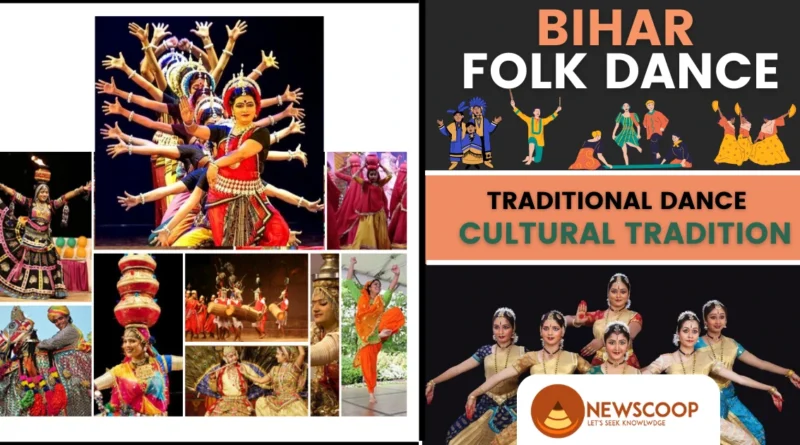10 Folk Dances of Bihar: List of Famous Traditional Names
Bihar, a state nestled in the eastern part of India, is renowned for its rich and diverse cultural heritage. The traditional folk dances of Bihar serve as a vibrant reflection of the region’s cultural tapestry. These captivating dance forms not only entertain but also narrate stories, foster social harmony, and celebrate the essence of life.
With their energetic footwork, rhythmic music, and colorful costumes, the folk dances of Bihar encapsulate the spirit and identity of the state’s cultural traditions. In this article, you will get to know about the famous traditional folk dances of Bihar that are important for the UPSC/BPSC Exam.
| Jat-Jatin | Jhumar |
| Jhijhiya | Sohar Khelwana |
| Karma | Kajari |
| Jharni | Krishi Naritya |
| Nachni | Natua |
Introduction to Bihar’s Folk Dances
Folk dance is a traditional form of dance that is passed down through generations within a community. It is a way for people to express their culture and heritage, often performed during festivals and celebrations. Unlike formal or classical dance forms, which are often codified and structured, folk dances have a more spontaneous and informal nature.
Bihar’s folk dances can be traced back to ancient times when they were an integral part of religious rituals, community celebrations, and storytelling. These dances have been a means of passing down traditions and preserving the cultural identity of different communities residing in Bihar. Over the years, they have evolved and flourished, incorporating influences from various dynasties, invasions, and cultural exchanges.

Famous Folk Dances of Bihar
Here are some famous folk dances of Bihar:
- Jat-Jatin Dance
- Jhumar Dance
- Jhijhian Dance
- Sohar-Khelwana Dance
- Karma Dance
- Kajari Dance
- Jharni Dance
- Krishi Nritya Dance
- Natua Dance
- Nachni Dance
1. Jat-Jatin Dance
- Jat-Jatin Dance is the most famous folk dance in North Bihar, particularly in the Mithila and Koshi districts.
- It is a couple’s dance that showcases the romance between Jat and Jatin, which serves as the central theme of the dance.
- The dance addresses various socially relevant issues such as poverty, love, grief, conflicts, and more, providing a platform for storytelling and expression.
- The dance not only entertains but also educates and raises awareness about important social issues.
- Jat-Jatin Dance continues to be cherished and performed, showcasing the artistic creativity and cultural pride of North Bihar.
2. Jhumar Dance
- Jhumar is a traditional folk dance of Bihar.
- It is performed by rural women.
- There is no fixed season for Jhumar; it can be performed at any time.
- The dance is characterized by rhythmic footwork, graceful hand movements, and vibrant expressions.
- Jhumar is a joyful celebration of rural women, showcasing their vitality and collective harmony.
- It brings together women of different ages and backgrounds.
- Jhumar is a cultural legacy that preserves the heritage and identity of rural communities in Bihar.
3. Jhijhiya Dance
- Jhijhiya is a cultural dance from the Mithila region of the Indian subcontinent.
- It is performed during the festival of Dusshera, dedicated to the goddess Durga Bhairavi.
- Women balance clay lanterns on their heads while dancing.
- The dance is believed to protect performers and their loved ones from negativity.
- It showcases feminine power and resilience.
- Jhijhiya preserves the cultural heritage of the Mithila region.
- It reinforces spiritual beliefs and fosters community unity.
- The dance symbolizes the triumph of light over darkness.
- It evokes hope, positivity, and reverence for the goddess.
4. Sohar-Khelwana Dance
- Sohar Khelwana is a traditional dance performed by women to celebrate the birth of a child.
- It is a part of the traditional rituals and celebrations in India associated with the arrival of a newborn.
- The dance involves singing Sohar songs and dancing to express joy and shower blessings upon the child.
- Women compare the newborn to revered Hindu Gods like Lord Rama and Lord Krishna in the songs.
- Eunuchs also participate in the dance, being an integral part of the celebration of childbirth.
- Sohar Khelwana strengthens community bonds and passes down cultural traditions from one generation to the next.
- The dance symbolizes the happiness and blessings that come with the birth of a child.
- The dance conveys prayers and well-wishes for the child’s well-being and a bright future.
- Sohar Khelwana promotes social acceptance and inclusion of diverse gender identities through the participation of eunuchs.
5. Karma Dance
- Karma Dance is a traditional dance named after the Karma tree, symbolizing fortune and good luck.
- The dance starts with planting the Karma tree, and dancers form circular formations around it.
- The group dance includes an equal number of male and female dancers.
- Dancers move backward and forward, towards and away from each other in a two-tiered formation.
- The rhythm of the drum and the clapping of the women guide the swinging movements of the dancers.
- The formation breaks, and dancers thread in and out with the bending of the torso and knees.
- Dancers form semicircular rows, with arms around their neighbors’ waists.
- Each row alternates between singing and dancing accompanied by Mandur and Timki instruments.
- The dance concludes on a joyful note, with fast and loud drum beats.
- The choreography is imaginative, and the songs’ themes are contemporary and relevant to the context.
6. Kajari Dance
- Kajari is a traditional song associated with the rainy season.
- The melodious tunes of Kajari songs evoke a pleasant feeling in the body.
- These songs are commonly heard from the start of the Shravan month, accompanied by the rhythmic notes of rain.
- During the Kajari dance, village women dance gracefully, resembling the movements of a peacock.
- The dance is accompanied by the popular Kajari song “Bhijat awe Dhaniya Ho Rama…“.
- The dance celebrates the joy and beauty of the rainy season.
- The dance movements are often inspired by the movements of peacocks and other elements of nature.
7. Jharni Dance
- Jharni Dance is a ritualistic dance performed by the Julaha community during Muharram.
- The dancers use bamboo sticks that are split at one end.
- They form a circular formation and move around while striking each other’s sticks.
- The sound created by the striking sticks serves as the beat for the dance.
- The circular movements and the sound of the sticks create a captivating visual and auditory experience.
- It is an integral part of the Muharram celebrations, adding color and energy to the festive atmosphere.
8. Krishi Nritya Dance
- Krishi Naritya dance is performed to celebrate the abundance of crops after the rains.
- The dance expresses the joy of farmers witnessing their fields flourishing with golden crops.
- It is a rhythmic and enjoyable dance form that showcases the happiness and gratitude of the farmers.
- The movements of the dance reflect the rhythmic motions of farming activities like sowing, reaping, and harvesting.
- Krishi Naritya dance is a celebration of the bountiful harvest and the hard work of farmers.
- It brings together the farming community, fostering a sense of unity and collective joy.
- The dance is a vibrant display of cultural traditions and the close relationship between agriculture and society.
9. Natua Dance
- Natua dance starts with an item called the Natua Kachal.
- It is a duet performance, with the dancers accompanied by musical instruments like Nagara, Dhol, and Shenai.
- The dancers wear indigenous and attractive costumes.
- The costumes add to the visual appeal of the performance.
- Natua dance showcases the cultural richness and traditions of Bihar.
- The dance movements are synchronized and create a harmonious rhythm.
10. Nachni Dance
- Nachni dance features a female dancer called the Nachni, who dances with her male partner, known as the Rashik.
- The dance is accompanied by singing and clapping performed by male accompanists.
- Nachni dances are typically performed at various festivals and special occasions.
- The Nachni not only excels in dancing but also showcases her singing skills during the performance.
- The dance is accompanied by musical instruments such as Nagara, Shenai, and Harmonium
Significance of Folk Dances in Bihar
The folk dances of Bihar hold significant cultural, social, and historical importance. Here are some key aspects highlighting the significance of these dances:

Preservation of Cultural Heritage: Folk dances of Bihar play a vital role in preserving the cultural heritage of the region. They are an integral part of the traditional customs, rituals, and festivals, passing down ancient traditions from one generation to another.
Expression of Identity: These dances are a means of expressing the unique identity and spirit of the people of Bihar. They reflect the social, religious, and historical aspects of the local communities, showcasing their beliefs, values, and way of life.
Community Bonding: Folk dances serve as a medium for community bonding and togetherness. They bring people from different backgrounds and age groups together, fostering a sense of unity, camaraderie, and collective celebration.
Celebration of Festivals and Special Occasions: The folk dances of Bihar are performed during various festivals and special occasions, adding color, vibrancy, and liveliness to the festivities. They enhance the overall festive atmosphere and create a sense of joy and excitement.
Entertainment and Recreation: These dances provide entertainment and recreation to both the performers and the audience. They offer a platform for artistic expression, creativity, and talent, while also captivating and engaging the spectators with their energetic and engaging performances.
Preservation of History and Legends: Many folk dances of Bihar are based on historical events, legends, and myths. They serve as a medium to preserve and transmit these stories through generations, keeping alive the rich history and folklore of the region.
Conclusion
In conclusion, the folk dances of Bihar are a vibrant expression of the region’s cultural heritage. They serve as a link to the past, preserving traditions and stories while fostering community unity and celebration. These dances play a significant role in showcasing the identity, values, and history of Bihar, captivating audiences, and promoting cultural tourism.
In addition, the folk dances of Bihar are a testament to the artistic talent and the rich tapestry of traditions that make the state’s cultural landscape so captivating and unique.
Thank You!
FAQs
What is the famous dance of Bihar?
The famous dance of Bihar is Jata-Jatin, a traditional folk dance performed as a couple dance in the Mithila and Koshi districts.
What are the names of popular folk dances of Bihar?
The names of popular folk dances in Bihar are Jat-Jatin, Jhumar, Jhijhiya, Sohar Khelwana, Karma, Kajari, Jharni, etc.
Which is the most popular dance in Bihar?
The most popular dance in Bihar is the “Jhijhian Dance,” a traditional folk dance performed by women and girls in circular formations, accompanied by clapping and singing during festivals.
Related links:

